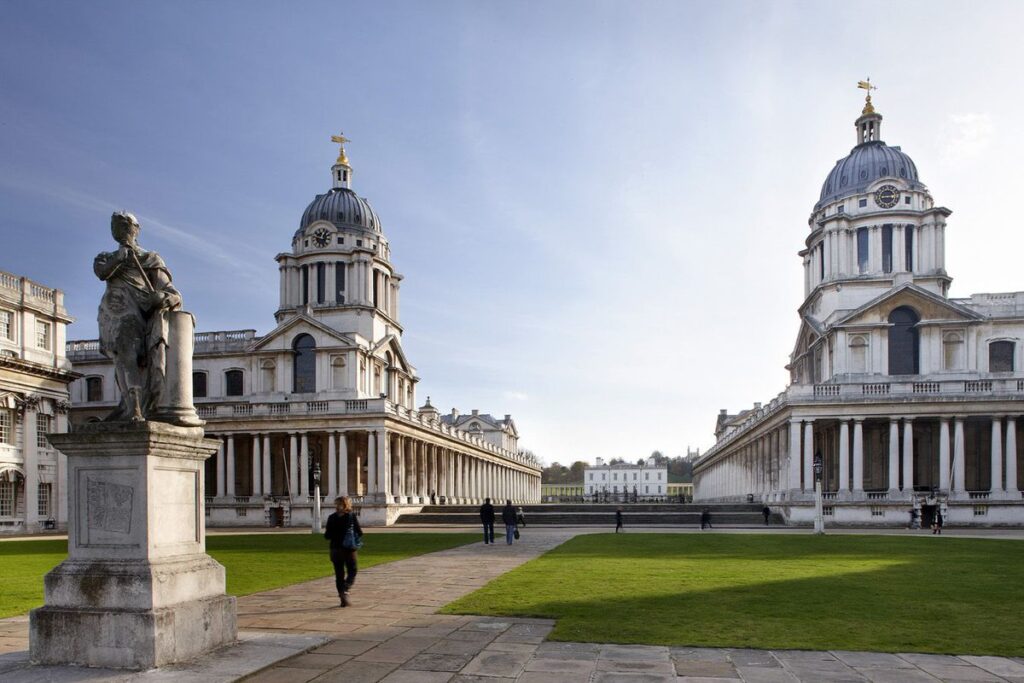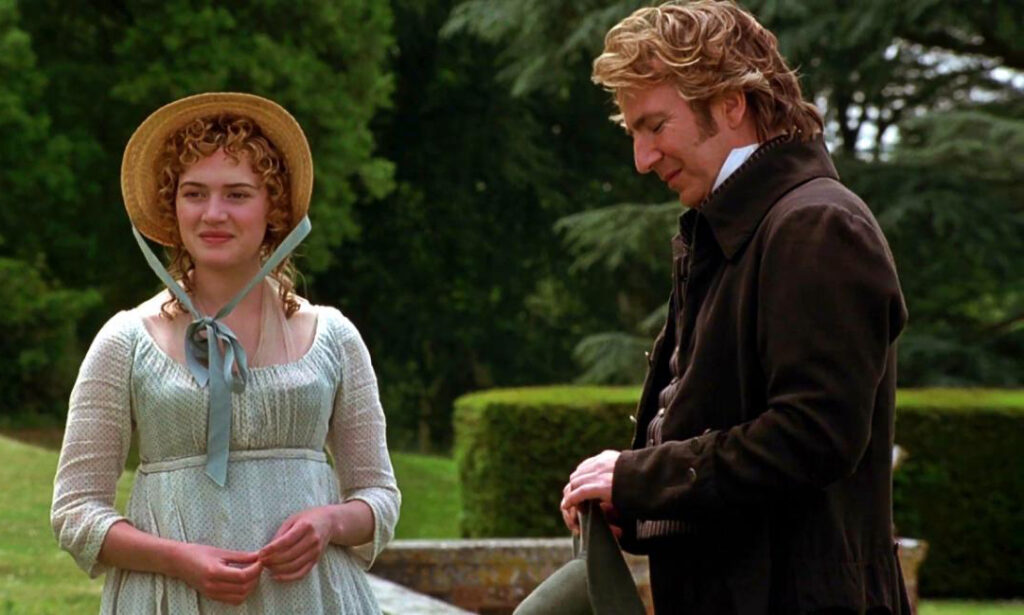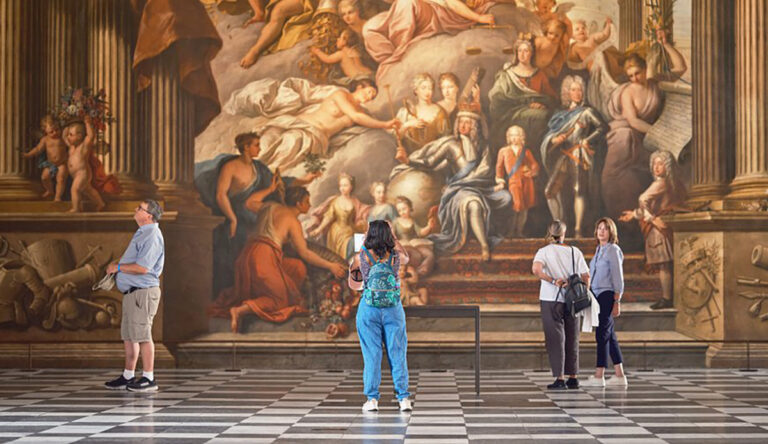From period pieces to dystopian movies and even the MCU and James Bond franchises, the Old Royal Naval College in Greenwich has lent itself to the backdrops of over 200 productions. As it ushers in its centenary this year, Luke Flynn—who heads Estate Operations at this UNESCO World Heritage site—shares some on-set/behind the scenes anecdotes. He also delves into how this prestigious venue has gone down in cinema history as the oldest known filming location.
*This interview has been edited for clarity.
Vidal D’Costa for The Movie Buff: Could you share with our readers a brief history of Old Royal Naval College? Especially about its current transformation into a popular filming venue?
Luke Flynn: The Old Royal Naval College in Greenwich, London, is one of the UK’s most historic and visually striking landmarks. [Iti is] described by Empire Magazine as “perhaps the most popular movie location in the world.” Designed by Sir Christopher Wren, the 17-acre site has served as a royal palace, a naval hospital, and a naval training college. This year marks 100 years since filming first began on site. The earliest known production being the 1925 silent film “Sons of the Sea.” Since then, the College has played host to over 200 film and television production. This [makes it]the UK’s number one heritage filming location.
Its stunning architecture and versatile spaces have featured in everything from “Pirates of the Caribbean,” “Les Misérables,” and “Skyfall,” to acclaimed series like “The Crown,” “Bridgerton,” “The Diplomat,” and “Slow Horses.” Directors such as Christopher Nolan, Kenneth Branagh, Ridley Scott and Guy Ritchie—who has filmed here six times—have all utilised the site’s cinematic appeal. The ORNC has also served as the backdrop for Oscar-winning performances from the likes of Colin Firth, Gary Oldman, Anne Hathaway, and Meryl Streep. [This has helped] cement its place as a go-to location for high-profile productions across genres.
VD: What is it about Old Royal Naval College that attracts filmmakers or location scouts?
LF: One of the key reasons filmmakers are drawn to the ORNC is its extraordinary versatility, both visually and logistically. The site’s timeless beauty and architectural grandeur—a harmonious blend of Baroque and Palladian styles—offer an adaptable canvas that can convincingly double for cities like Paris, Florence, Berlin, Moscow, Washington, and even the fictional Lilliput! Despite appearing in over 200 productions, it has only played itself three times (“Sons of the Sea,” “Thor: The Dark World,” and “The Foreigner”). This flexibility is a direct result of conservation efforts and the site’s unique status as a UNESCO World Heritage Site. [This is in addition to a] charitable estate, museum, university campus, music school, and public space all in one.
One of the key reasons filmmakers are drawn to the Old Royal Naval College is its extraordinary versatility, both visually and logistically“
Luke Flynn
Importantly, it is not just the look of the buildings that appeals to filmmakers]. It’s how practical the location is for large-scale productions. With 17 acres of private grounds, the site allows technical vehicles to park without road closures or external bookings. [It also] supports facilities for catering, green rooms, restrooms, stabling animals, and accommodating hair, makeup and costumes.
To a filmmaker, the College becomes a functioning backlot, capable of hosting multiple units and large crews simultaneously. Known in industry terms as a “composite site”—a slightly unglamorous phrase perhaps—it has played host to everything from period dramas and action thrillers to horror and sci-fi. The Painted Hall has stood in for palaces, the Chapel has welcomed wedding guests from The Bridgertons, Doctor Strange, and Elton John, and even one of our ladies toilets had a cameo in “The Diplomat!” Because the site is so adaptable it can easily provide the backdrop to period dramas or modern-day espionage. It’s a canvas for creativity.

VD: Since the site is a UNESCO World Heritage monument, there are obvious challenges in safeguarding it. How do you oversee such challenges? It is hard to interact with a film crew in to ensure there’s no damage to its iconic architecture?
LF: From liaising with production companies and facilitating site access to negotiating contracts and safeguarding our buildings, [we coordinate] every aspect of filming to balance the preservation of the site with the demands of the production.
A key challenge we face is maintaining the integrity of our UNESCO World Heritage site while accommodating commercial filming. To manage this, we implement strict guidelines to protect the site. This includes working closely with Historic England to secure necessary permissions for any modifications or temporary structures, ensuring that productions adhere to our protocols.
When it comes to physical protection, the preservation of the site is our top priority. We employ a range of methods to safeguard the architecture: matting is laid to protect floors, particularly in high-traffic areas; custom protection is applied to marble steps to distribute weight when items are carried up; and heavy objects are placed on ply boards to prevent pressure points.
Additional precautions are taken with lighting and props, ensuring they’re kept at a safe distance from vulnerable areas. Open flames or atmospherics are only permitted if specifically agreed upon in advance and after thorough scrutiny and testing. Before filming begins, each production company must agree to these restrictions, and my team ensures [compliance] throughout the shoot. While compromises may occasionally be necessary, our primary responsibility is to safeguard the fabric of the building. It’s a delicate balance. We [manage it] carefully to ensure the site remains undamaged while allowing filmmakers to realise their creative vision.
One of my personal favourite scenes, featuring two of my favourite actors, was filmed here in “Patriot Games” back in 1991…”
Luke Flynn
We also prepare for the unexpected. Flexibility is essential, as last-minute changes can occur, whether due to script revisions, talent availability, or unforeseen production challenges. Over time, we’ve become adept at being adaptable and proactive, creating backup plans to minimise disruptions. A two-way flow of communication between our team and the production crew is critical. [It helps] to avoid misunderstandings and to ensure the shoot runs smoothly while safeguarding the site.
VD: What are some of your personal favourite movies or shows that have been filmed at Old Royal Naval College, or in the neighbouring locations (The Painted Hall, Chapel of St. Peter, and St. Paul, etc)?
LF: One of my personal favourite scenes, featuring two of my favourite actors, was filmed here in “Patriot Games” back in 1991, when the site was still run by the Royal Navy. In this scene, Harrison Ford, as Jack Ryan, intervenes in a terrorist kidnapping amid a hail of gunfire and an exploding car rigged by Sean Bean’s character. This opening moment sets the tone for the rest of the film. It’s thrilling to know such an intense sequence was filmed on ORNC grounds—whilst ensuring no damage to the site!

“Thor: The Dark World” is another standout. This is particularly true for its extensive use of our site during [its] climactic battle with the Dark Elves. One of the more understated moments shot here was when the College served as a modern-day Florence café in “The Dark Knight.” Most people (myself included) assumed it had been filmed in Italy!
I’m also excited for the upcoming “Jurassic World” film, which was shot here last year. While I can’t reveal too much about the scenes filmed on our site, we did feature in the trailer. As a big fan of the original “Jurassic Park“, it was a fantastic experience to have the production here. I’m really looking forward to seeing how the Painted Hall has been integrated into the new film.
VD: Could you share some details with us? What can visitors expect to experience during the new film tours commemorating 100 years of filming at ORNC?
LF: To commemorate our filming centenary, we’re launching two exclusive new film tours in 2025. [They] will allow visitors to go behind the scenes and discover the closely guarded secrets of filmmaking on our site. With over 200 productions to draw from, it’s impossible to include them all. [However], we’ve chosen to highlight the rich diversity of genres filmed here. [This is particularly true] with our strong reputation in period dramas, as well as superhero and spy thrillers.

The first tour, “Wigs, Weddings, Powder and Palaces,” takes visitors through the world of period dramas. [It draws inspiration] from the elegance of “Bridgerton.” This immersive behind-the-scenes experience invites guests to step in the shoes of the stars and onto the very sets that brought their favourite scenes to life. One of the highlights of this tour is a fun and interactive 15-minute class on hand fan etiquette. Participants can learn the secret meanings behind the graceful gestures used by characters in historical dramas.
I’m also excited for the upcoming “Jurassic World” film, which was shot here last year.
Luke Flynn
The second tour, “Spies, Super Sleuths, and Superheroes,” will take a closer look at some of the most thrilling spy and superhero productions filmed on-site. [These include] “Skyfall,” “Operation Mincemeat,” “Sherlock Holmes,” “Slow Horses,” and “Kingsman,” among others. This tour will also feature a themed interactive element. Visitors [will have] the chance to get hands-on, learn about the tricks of the trade, and explore the techniques that bring these blockbuster scenes to life.
Both tours offer fans an exclusive, interactive experience, taking them beyond just the visual spectacle and delving into the fascinating world of film production.
The Movie Buff thanks Luke Flynn for his time in talking with us. For those interested, you can book tickets to the exclusive walking tours here.


